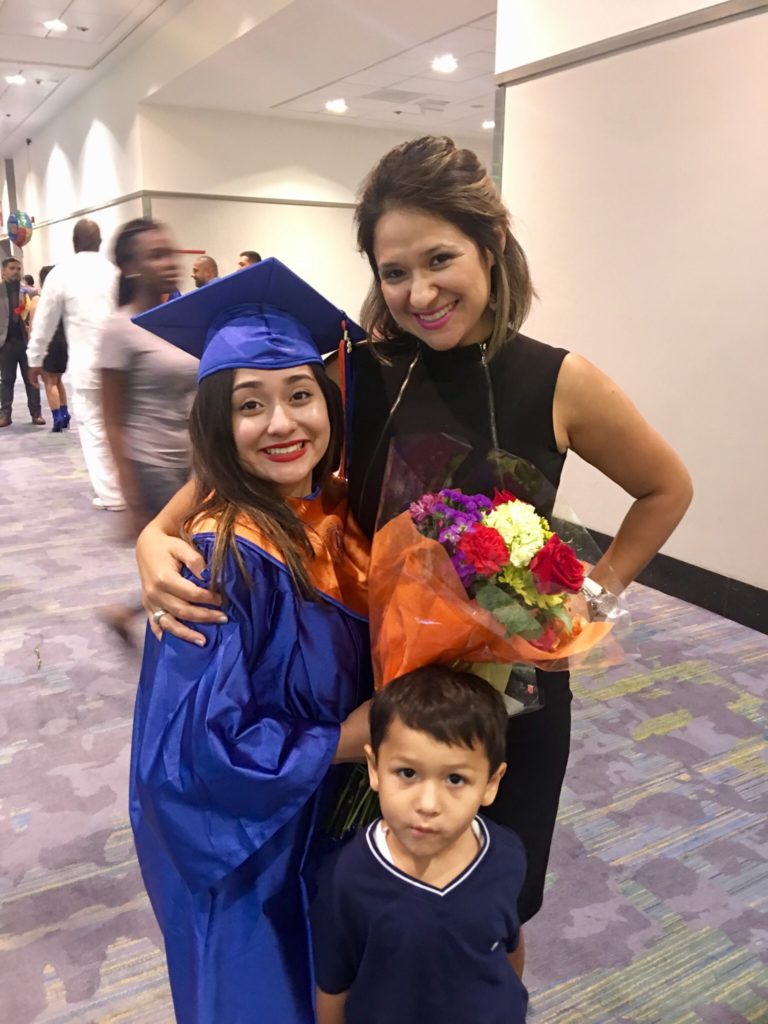In August 2017, my firstborn was about to start her senior year at Whitney Young. Meanwhile, my toddler was about to begin his educational journey. The 14 year-age gap between my children spans my educational journey from teenage mother to graduate of Georgetown and Harvard.
My daughter was born when I was 14 years old. In the summer of 2005, after completing my first year of college, I returned to Chicago. My summer would be spent interning for Congressman Bobby Rush and researching preschool programs for my daughter. At the time my points of reference for her schooling were my student experience in neighborhood schools, plus my experiences with my mentor and my Georgetown classmates.
The culture shock of moving from my CPS education to Georgetown was too big to ignore. I knew Deztinee would need to be more prepared for college. She needed to be a confident learner and scholar who would always have agency.
Deztinee spent her preschool years at the neighborhood school. When I started researching kindergarten programs, she tested at a few schools and the results said “she was average.” I went to Andrew Jackson in hopes of speaking with the principal, no luck. I wrote a letter to the principal to please consider us to be a promising family with an even more promising student, no luck.
I researched more CPS schools and came across Suder Montessori. I did not know anything about Montessori education. All I knew was that the mentor who helped pave my way to Georgetown attended Montessori school as a child.
Suder was a new school. My daughter would be a guinea pig in the district’s second Montessori School. She would leave her community everyday to attend school. Our family would need to figure out how to transport her from our neighborhood to the new school. But all would be worth it to ensure she was better equipped for college than her teenage mother had been.
The Montessori education at Suder set her up for lifelong success. It instilled agency, hands-on learning, compassion, and the academic skills to be admitted to the illustrious Academic Center at Whitney Young. She just graduated this June and will head to the University of Illinois at Urbana-Champaign on a full scholarship in the fall.
Sometimes, Different Children Need Different Schools
Naturally, I should have been ready to enroll my 3-year-old son at Suder, too. But I was not. As a former CPS teacher and school administrator who believes in ensuring the collective success of neighborhood schools, I felt a huge sense of responsibility to send my own child to the local school.
Additionally, unlike his older sister, who spent a lot of her early years with my mom while I completed high school, my son did not have a firm grasp of our native language, Spanish. I had to make a decision. So I asked myself, what matters most in educating my second child: Native language? Pedagogy? My beliefs about neighborhood schools?
I visited a local school and met with my son’s future teacher. I sat on the decision over the weekend. I decided to hold off on preschool. Instead I would spend the year doing what I never had time to do with my first child, stay home and observe.
After a few days at home together, I decided to structure his week and enrolled him in a local park district. He continued his Saturday music class at the Bienen School of Music in Evanston. He spent countless days at museums, libraries across the cities, our local zoo, and occasionally traveling to Mexico.
From observing my second child, I realized a few things about him and his way of learning. He is a habitual reader. He reads when he wakes up, before nap time, and before bed time. His attention span is short for structured activities. He does not enjoy sitting down in a chair for too long. He will not sit easily to grasp letters, numbers, or colors. He would rather count items in the books he reads, pick up rocks outside, and collect tree branches. He does not care to know the letters of the alphabet but he will name plenty of dinosaurs and animals in Spanish and English. He no longer wants to be an elephant when he grows up; instead, he wants to be a penguin. His daily ritual begins with, “Good morning, Mom! Where are we going today?”
Raising a bilingual and bicultural student is still important and developing a life long learner who has agency is now even more important. My beliefs about education can influence my decision on where to enroll my child, but ultimately it’s his personality and way of learning that should dictate where he will be best nurtured.
After learning more about different educational philosophies I was drawn to the Waldorf method. Emiliano reads to his stuffed animals, discusses his dreams every morning, and there is nothing he would rather be than a penguin.
Montessori and Waldorf education share many similarities; in particular, they promote attention to and respect for the individual. However, a key difference between the two methodologies is that a Waldorf education focuses less on formal academics in the early years and instead centers learning around projects, imagination, and creativity.
However, the financial costs of Waldorf education are not within our means. Emiliano is 243 on the Suder waitlist. We shall go back to the drawing board.

1 comment for “From Teenage Mother to Harvard Grad to Just Another Chicago Parent Looking for the Right School”